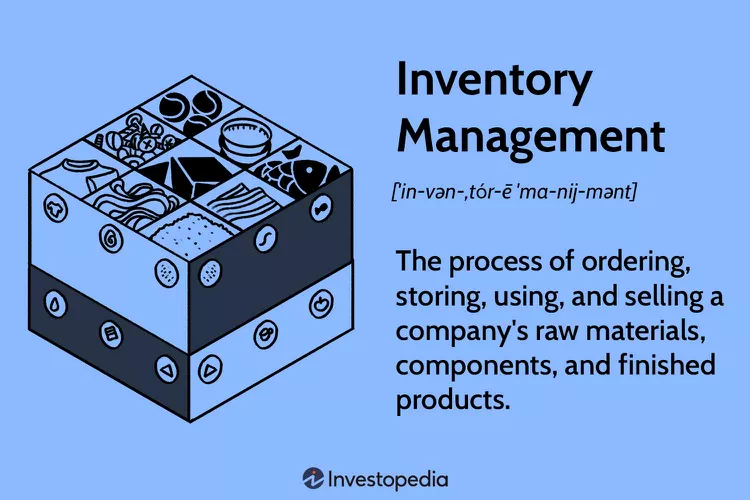To truly appreciate inventory management, we must focus on relatable examples and benefits. For instance, a reputable home goods manufacturer supplies a retail chain with popular kitchen appliances. As holiday demand rises, their production team fails to deliver its regular supplies due to resource overestimation. Retailers are with empty shelves. Competitors take advantage and dominate sales. Boom! Customers switch camps.
Now be careful here. Effective inventory management goes beyond meeting demands. It also ensures your business’s resources aren’t overcommitted, preventing essential cash from being tied up. With better inventory management, shelves remain stocked, your suppliers and customers find what they need, and sales soar.
This guide offers step-by-step examples to help you develop a standard inventory management plan that your entire team can adopt. You’ll also master best practices and implementation standards to ensure your business operates at peak excellence.
Statistics about inventory management’s connection to sales success
Research indicates that poor inventory visibility often results in late shipments, leading to increased customer disappointment. Approximately 34% of retail businesses ship orders late due to selling out-of-stock products, highlighting the critical need for effective inventory management.
Interestingly, 28% of warehouse leaders identify improving customer satisfaction as their top priority, underscoring the importance of efficient inventory practices.
Whether you’re at the helm of a small boutique or a multinational supply chain, exceptional inventory management requires strategic foresight. It’s a critical driver of sustainable growth and long-term success.
What is inventory management?
Inventory management is the process of tracking and managing products or production resources to ensure that a company maintains the right balance between having enough inventory (stock, supplies, goods) to meet customer needs and avoiding excess stock that can tie up resources.
Overall, it is about keeping the right balance, making sure a business has just enough of what it needs, when it needs it, without overdoing it or falling short. Think of it as the behind-the-scenes magic that keeps everything running smoothly.
A smart approach to inventory management isn’t just about counting what’s on the shelves, it’s about aligning with business goals. By using tools like forecasting software, just-in-time (JIT) methods, or automated systems, businesses can strike the perfect balance between supply and demand. The result? No more overstocking or running out of essentials, which means better efficiency, lower costs, and a healthier bottom line.

Benefits for different stakeholders
Inventory management delivers many benefits to key stakeholders:
- Business owners: For business owners, effective inventory management translates into higher profitability and cost savings. By keeping stock levels just right, not too much, not too little, you can save on storage, avoid waste, and free up cash for other priorities.
- Managers: Managers benefit from streamlined operations and improved decision-making. With accurate inventory data at your fingertips, you can forecast demand, plan production schedules, and tackle market changes without breaking a sweat. It also reduces the stress of handling supply chain disruptions.
- Customers: When inventory management is on point, customers enjoy a seamless shopping experience. They can trust that the products they need are always available, leading to increased satisfaction and loyalty. Businesses that consistently meet customer expectations often gain a competitive edge in the marketplace.
By focusing on the unique needs of each stakeholder, inventory management becomes more than just a backend operation; it becomes a driver of success for the entire business ecosystem.
Core principles of inventory management?
Effective inventory management relies on a few tried-and-true principles that help businesses stay efficient, cut costs, and meet customer demands. These principles form the backbone of a well-organized and profitable inventory system:
- Just-in-time (JIT) inventory: The JIT principle ensures that inventory is ordered and received only when it’s needed, reducing waste and storage costs. This approach requires precise coordination with suppliers but can significantly improve cash flow and operational efficiency.
- Economic order quantity (EOQ): EOQ focuses on finding the ideal order quantity that minimizes both ordering and holding costs. By calculating the balance between these costs, businesses can maintain optimal stock levels without overspending on storage or frequent orders.
- ABC analysis: Not all inventory items carry the same importance. ABC analysis categorizes inventory into three groups:
- A: High-value items with lower sales frequency.
- B: Moderately valuable items with average sales.
- C: Low-value items with high sales frequency.
This prioritization helps businesses focus their efforts and resources on the most impactful inventory.
- Inventory turnover ratio: This ratio measures how quickly a business sells and replaces its inventory over a given period. A high turnover ratio indicates strong sales or efficient inventory management, while a low ratio may signal overstocking or slow-moving products. Monitoring this ratio helps businesses make informed decisions about stock levels and purchasing strategies.
By applying these principles, businesses can reduce costs, improve efficiency, and create a more agile supply chain, all while ensuring customer satisfaction.
Steps to implement an inventory management plan for your business
Let’s say you own a retail business, FreshMart, specializing in organic groceries. Here’s a step-by-step guide to implementing an efficient inventory management plan to keep your shelves stocked and your customers happy [You can also adapt this example to fit different industries]:
Step 1: Conduct a pre-implementation assessment
Before implementing changes, understand your current inventory situation.
- Audit existing practices: Perform an inventory management store audit to examine how inventory is tracked, stored, and replenished. Are inefficiencies causing stockouts or overstocking?
- Identify gaps: Determine where you lack resources or processes, such as demand forecasting or accurate categorization.
Step 2: Set clear inventory goals
Define measurable objectives for your inventory plan.
- Reduce waste: Set a target to lower spoilage of perishable goods by 20% within six months.
- Improve availability: Ensure top-selling items like organic milk are consistently in stock to meet customer demand.
Step 3: Implement inventory tracking and categorization
Streamline your inventory by tracking items and organizing them effectively.
- Categorize inventory: Use ABC analysis to prioritize items by value and importance—focus on premium products (A), essentials (B), and bulk goods (C).
- Adopt tracking tools: Invest in inventory management software or use checklists (as demonstrated in the Lumiform section) to log real-time stock levels, movement, and location.
Step 4: Leverage demand forecasting
Anticipate customer needs to make informed decisions.
- Analyze historical data: Look at past sales trends to predict future demand, especially for seasonal or high-demand items.
- Incorporate external factors: Adjust forecasts based on market trends, holidays, or local events that may influence buying patterns.
Step 5: Set reorder points and manage safety stock
Avoid stockouts and overstocking by defining thresholds.
- Establish reorder points: Set a minimum inventory level that triggers replenishment orders, e.g., reorder organic apples when the stock falls below 30 pounds.
- Determine safety stock levels: Keep a buffer stock of essential items to handle unexpected surges in demand or supplier delays.
Step 6: Choose the right inventory management tools
Select tools suited to your business size and needs.
- For small operations: Start with spreadsheets or basic inventory apps.
- For growing businesses: Use advanced tools like QuickBooks or Zoho Inventory for features like barcode scanning and automated tracking.
Step 7: Train your team
Ensure your employees are equipped to implement the plan effectively.
- Standardize processes: Teach staff how to use inventory tools, perform accurate counts, and follow protocols.
- Promote accountability: Encourage team members to flag discrepancies and suggest improvements.
Step 8: Optimize inventory levels
Balance supply and demand to prevent shortages or excess stock.
- Just-in-Time (JIT): Minimize holding costs by receiving inventory only when needed, especially for perishable goods.
- Economic Order Quantity (EOQ): Calculate the EOQ order sizes that reduce ordering and holding costs simultaneously.
Step 9: Build strong supplier relationships
Learning how to audit your supplier pool for the most reliable supplier is key to consistent inventory flow.
- Negotiate flexible terms: Work out arrangements that allow for small, frequent orders to avoid overstocking.
- Communicate proactively: Update suppliers about changes in demand or issues like delays.
Step 10: Conduct regular audits and reviews
Ensure inventory accuracy and identify improvement areas.
- Cycle counts: Check high-value or fast-moving items weekly to ensure records match actual stock.
- Investigate discrepancies: Trace mismatches to find and resolve process gaps.
Step 11: Monitor key metrics
Use KPIs and data-driven insights to refine your plan.
- Track inventory turnover: Measure how quickly products sell to identify fast and slow-moving items.
- Evaluate customer feedback: Regularly survey customers to ensure your inventory meets their needs.
Step 12: Continuously improve the plan
Inventory management is an evolving process.
- Incorporate feedback: Use input from employees, customers, and suppliers to tweak and improve processes.
- Adopt new technologies: Consider advanced tools like platforms offering custom inventory management checklists and solutions like Lumiform. You can also track trends from AI-powered forecasting innovations or RFID tracking as your business grows.
By following these steps, FreshMart can efficiently manage its inventory, minimize costs, and ensure customers always find the fresh organic products they need. Ready to revolutionize your inventory management? Start implementing today!
Common challenges and solutions
Managing inventory effectively involves challenges like inaccurate tracking, overstocking, and inefficient storage. Solutions include using barcode systems for real-time tracking, demand forecasting tools to set reorder points, and categorization methods for organization. Automate processes to reduce errors, diversify suppliers to handle disruptions, and optimize purchase quantities to lower costs.
Use your Lumiform inventory checklist & automation tools
Are you facing challenges with overstocked warehouses or empty shelves? Inefficient inventory management can lead to wasted resources and missed sales opportunities. Our inventory management checklist template solutions address these issues by allowing you to track all your inventory tasks in one place. Review, crosscheck, and receive progress updates on the go, ensuring you have all the information you need before giving your approvals. Streamline stock tracking, enhance resource allocation, and maintain seamless supply chain operations with our platform, helping you achieve high efficiency, reduce risks, and continuously optimize for sustained success.
Tools and technologies to look out for
Effective inventory management relies on tools like inventory software (Zoho Inventory, QuickBooks), which provide real-time tracking and automated updates. Barcode and RFID systems simplify stock tracking, while ERP systems integrate inventory with sales, procurement, and finance. AI-powered forecasting tools analyze data to reduce overstocking or shortages, and cloud-based solutions enable remote access and scalability. These technologies streamline operations, improve accuracy, and save costs.
Perform your first inventory check for free!
Mastering inventory management is the key to driving efficiency, reducing costs, and delivering exceptional customer satisfaction. By addressing common challenges with the right tools, strategies, and systems, businesses can turn inventory management into a competitive advantage. Whether you’re struggling with tracking accuracy, forecasting demand, or optimizing stock levels, adopting modern solutions like Lumiform can revolutionize your operations.
Ready to streamline your inventory management journey? Try 18 powerful, ready-made inventory management templates from Lumiform today, all for free. Take your first step toward a smarter, more efficient inventory system.
